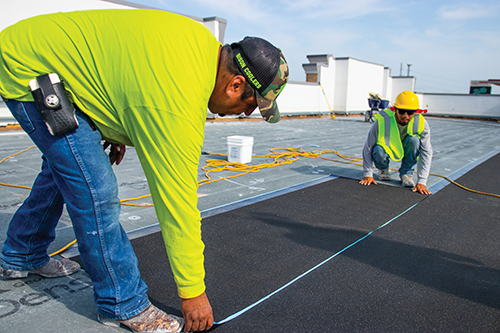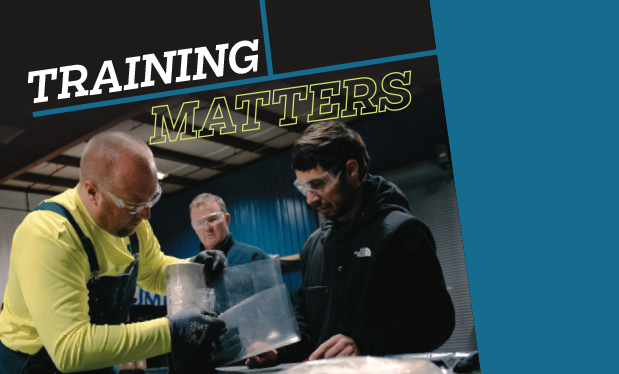Editor’s note: The views in this article represent those of the author and not necessarily NRCA or Professional Roofing.
Long before the current worker shortage, finding and retaining skilled labor has been a challenge for the construction trades. This is especially true in commercial roofing where experience is required to complete jobs in a way that is timely and cost-effective. Roofing contractors are expected to deliver quality, watertight low-slope roof systems with limited labor resources while still turning a profit. However, with leaner operations, contractors have less time for self-analysis and fewer opportunities to improve their abilities to control and reduce labor expenses.
Understanding the pressures facing contractors, roofing manufacturers have attempted to address the construction labor shortage by offering products that require less skill, time and effort to install. Self-adhering polymer-modified bitumen roof membranes have been marketed as a labor-saving solution to traditional bituminous products, which require torched or hot-mopped membranes or membranes set in cold adhesive.
To help commercial roofing contractors make more informed product decisions, CertainTeed Corp., Malvern, Pa., commissioned Trinity|ERD, a Seattle-based building envelope consulting firm, to conduct “Factors Impacting Low-Slope Roofing: A National Labor Study,” a study to quantify the labor differences among self-adhering polymer-modified bitumen membranes, traditional bituminous systems and single-ply roof coverings. This independent, five-year project looked at the installation of 45 roof systems with six roof coverings in multiple configurations in five U.S. regions. The researchers isolated and timed product and task-level installation data and observed where efficiencies or inefficiencies occurred.
Although the study results clearly indicate labor advantages based on product selection, they also highlight the many factors that affect crew efficiency. A contractor’s ability to turn a profit is determined by more than just the products being used on a particular job. It also is influenced by the contractor’s ability to optimize his or her crew’s efficiency through proper training and effective team communication, crew management and tool use. Accurately pricing jobs also requires an understanding of the amount of time it takes crew members to perform certain tasks.
The CertainTeed study can help contractors better understand labor efficiencies by product, more accurately estimate the labor associated with certain tasks and improve installation efficiency across all roof covering types.
Comparing labor
To have an equal comparison of labor efficiencies across roof coverings, the task-level data collected by product was applied to a sample project. The sample project included the following parameters:
- 500 squares
- 900 lineal feet of base flashing
- Six drains
- 10 4x8 curbs
- 12 field-flashed pipes
To translate labor time into dollars, the sample project assumed a national labor rate of $45 per hour, based on a 30-city average published by RSMeans, North America’s leading construction cost database. The average was determined from labor union agreements or prevailing wages for construction trades for 2016 and takes into account individual employee-associated costs—such as medical coverage, workers’ compensation, etc.—as well as company overhead and profit markups. This method of formatting the data allowed Trinity|ERD to assess the effect that varying project features—such as number of drains—have on labor efficiency.
The labor study confirmed clear, measurable differences in labor efficiencies across roof covering types. For example, a bituminous roof covering consisting of a mechanically attached base and a self-adhering cap sheet was faster to install than the same base sheet covered with either a torched or hot-mopped cap sheet or a single layer of either TPO or PVC membrane. Flashing details accounted for a significant percentage of project labor, particularly on base flashings and equipment curbs. When installing bituminous roof coverings, details with self-adhering components offered labor savings even when the field application was completed with a torch or mop. Also, flashing details accounted for a larger percentage of labor on single-ply projects than multilayer bituminous projects.
The roof covering that was fastest to install was a two-ply bituminous system with a mechanically attached base sheet and a self-adhering cap sheet; the roof system that was the slowest to install was a bituminous system with the base sheet and cap sheet applied with hot asphalt. The self-adhering roof covering required 54.2 labor minutes per square; the mopped cover required 156.5 labor minutes per square, a difference of 102.3 labor minutes per square (2.89 times), or $38,390.63 in sample project labor costs.
When comparing the same mechanically attached base sheet with a self-adhering cap sheet to a mechanically attached 10-foot, 60-mil TPO covering, the TPO requires 114 man-minutes per square. This is 2.11 times the labor of the self-adhering cap sheet solution, or a difference of $22,528.50 in labor costs.
The data also indicate several important considerations for flashing details. Referencing the sample project, on average, 24% of the total man-hours on the multilayer bituminous systems are allocated to accessory detailing whereas the same work on the single-ply roof coverings required 31% of the total man-hours. Therefore, one can conclude projects with a relatively high number of flashing details may warrant stronger consideration for multilayer bituminous roof coverings as opposed to single-ply coverings to reduce labor expense and total project cost. However, the type of flashing detail has significant bearing on the labor required and the difference in labor across roof coverings. Base flashing and equipment curbs require more labor and have a wider delta for observed time to complete across roof coverings.
Both the raw data collected and sample project data illustrate the potential labor savings associated with self-adhering bituminous coverings.
Comparing installed costs
Although labor costs were the study’s focus, roofing contractors sometimes make product purchasing decisions based on installed costs. To provide an installed cost comparison, the observed labor data from the study was combined with national material/product average pricing gathered from 22 roofing distribution outlets throughout the U.S. responding to a request for a proposal for 500 squares of products.
The responses revealed self-adhering and torch-welded two-ply polymer-modified bitumen systems can be installed cost-competitively with single-ply systems. The least expensive installed roof covering was a bituminous mechanically attached base sheet and a bituminous torch-applied cap sheet applied with a multitorch cart; the most expensive was a two-ply, nonpenetrated (adhered base and cap sheet) bituminous system, mop-applied in hot asphalt.
Single-ply installed costs vary by material and increase with thickness, as well as from a mechanically attached to an adhered covering. There was a 20% difference between the least-expensive single-ply covering (mechanically attached, 60-mil, 10-foot-wide TPO) to the most expensive (fully adhered, 60-mil, 10-foot-wide TPO). The two-ply, self-adhering polymer-modified bitumen roof systems installed for about $93,000—$4,000 more than the least expensive single-ply system and $18,000 less than the most expensive single-ply system.
There are large variations in the amount of labor spent to install various roof coverings compared with the cost of materials. On average, the installed cost of bituminous assemblies is composed of 36% labor cost while the average installed cost of the single-ply roof coverings consists of 49% labor.
The installed cost for the fastest installed system—the mechanically attached base with self-adhering cap sheet—is 22% labor. From the perspective of a building owner, with the same dollars to spend on a two-ply, self-adhering polymer-modified bitumen roof system or PVC or TPO single-ply covering, the polymer-modified bitumen system provides two layers and 200 mils of water protection for a 78% investment compared with one layer and 60 mils of protection for a 49% investment.
Obtaining the data
Significant effort was made to minimize key variables on observed projects. For example, all observed projects took place in temperate climates with crews that were equally experienced. Additionally, when key variables were identified—such as when tools broke down or unorganized/unmanaged crews caused delays—the related downtime was recorded separately.
For the study’s purposes, a roof covering was defined as all materials installed above the insulation and/or cover board, including any anchor sheet layers, adhesives, fuel (propane) or fasteners. The findings incorporated labor data from the following:
- Installation of base, ply and cap sheets
- Installation of base flashings on low, wood parapet walls
- Installation of flashing details such as pipe, drains and equipment curbs
- Rooftop work performed by foremen and superintendents
- Quality control efforts during the primary installation
The data did not include:
- Labor related to tear off
- Material transportation
- Roof loading and staging
- Site cleanup
- Installation of insulation or cover board
- Nonworking managerial time
- Quality control efforts after the primary installation
Data collected in the field was validated by 2016 data published by RSMeans. RSMeans labor costs are based on the average of wage rates from 30 major U.S. cities. Rates are determined from labor union agreements or prevailing wages for construction trades for the current year. Overhead and profit markups were included in the published rates. No scope of work generated in time trials for the labor study had an average time greater than that published by RSMeans.
In specific regions, roof estimators were asked to share data from their estimating programs for time required to carry out specific segments of work. The shared data was compared with actual collected data. Wide variables were identified with some penetration flashings, such as drains. Consistently, estimators applied longer periods of time to flash drains for all system types than recorded. This also was consistent with hot stack flashings. Conversely, the installation of termination bars into concrete at the top of a base flashing was consistently underestimated when compared with the time trial data.
Tools and management
The ability of a crew to quickly and profitably install a low-slope roof system cannot be isolated to the specific type of roof covering being installed. A roofing crew’s efficiency also is affected by climate, project parameters, tools, safety requirements, quality requirements and crew management. Roof estimators and managers should clearly identify the factors affecting their crews, optimize productivity when possible and adjust their estimates accordingly.
The study also observed roofing contractors can do a lot, regardless of roof covering type, to improve their crews’ productivity and bottom lines. Here are some examples:
- Factor in temperature and environment. Environmental factors always should be factored into project estimates. Cold weather often adds work in the form of heating adhesives, longer time periods for relaxing rolls and longer welding times of membranes not to mention decreased mobility from bulky cold-weather clothing. Heat often causes fatigue and makes workers thirsty, resulting in more break periods. Also, nighttime projects are typically slower than daytime projects as work areas are constrained to lighted areas and tools are harder to locate.
- Staging and assignments. Installation is easiest when a crew works as a coordinated team. Language barriers among crew members tends to increase installation time. Crew members are most productive when their individual work is narrowly defined as opposed to a range of tasks. For example, when handheld screw guns were used, workers who staged and placed screws and plates as one phase of work and were followed by another crew member who installed them were more efficient than a single person carrying pouches of screws and plates. The rhythm of work is maintained when a worker focuses on a single task. Staging materials properly for installers ahead of time also makes projects move more quickly.
- Strong management and quality control. Rooftop supervision and direction plays a key role in quick installation times. This includes proper management of rooftop loading, break times, staging materials, prefabrication (such as combining screws and plates) and relaxing materials before installation. A lack of in-application quality control saves time and labor on the front end but typically requires a crew to go back and correct issues noted by inspectors. In-application quality control would help avoid the time and money wasted sending crews back to a job site to complete repairs.
- Using tools wisely. Efficient tool and accessories use has a measurable effect on installation times. For example, the installation of a bituminous cap membrane with a multitorch cart was completed 86% faster compared with using a handheld torch. Automated screw and plate installers offer a noticeable time advantage but require a knowledgeable mechanic or crew member with rooftop access to spare parts to avoid machine jams or malfunctions. Poorly maintained automatic welders with inconsistent power and/or damaged parts also can slow productivity and negatively affect application quality. Blowers used on roofs to clean surfaces and move large sections of membrane also increased productivity in multiple applications.
Key findings

CertainTeed originally set out to determine whether self-adhering roof coverings deliver on the labor savings they aspire to provide. The study quantifies and confirms self-adhering coverings can be installed in less time than other bituminous application methods as well as single-ply coverings, including TPO and PVC.
Assessing installed cost, per sample project parameters, the least expensive roof covering was a bituminous mechanically attached base and a multitorch-applied cap sheet. Although not as fast to install as a self-adhering cap sheet, torch-applied materials tended to have lower cost. The self-adhering bituminous coverings were installed cost-competitively with single-ply coverings.
The data indicate detail application can have a significant effect on project costs and profits. Bituminous self-adhering detail application, as with field application, offers reduced labor over other bituminous applications and single-ply coverings. Increased acceptance of bituminous self-adhering systems may start with proposing hybrid systems with a self-adhering roof cover and hot-applied or torch-applied flashing and penetration details.
Under ideal conditions on a singular sample project, the relative installed cost and labor comparisons are clear: Product selection indisputably has an effect on labor efficiencies, but it would be inaccurate to name any one low-slope roof covering the fastest or most cost-effective for all projects or contractors.
The perceived value in one system may not carry across every roof system design or meet what is needed for the local climate. All aspects of a project must be incorporated into product and roof assembly selection. Further, installation requires a level of expertise with quality control and assurance to ensure long-term performance is as intended. Although project parameters and management apply a high degree of variability to every job, proper training, project management and crew management can significantly increase efficiency and help contractors extract the most profit from projects.
Abby Feinstein is product manager, commercial roofing, for CertainTeed Corp., Malvern, Pa.



